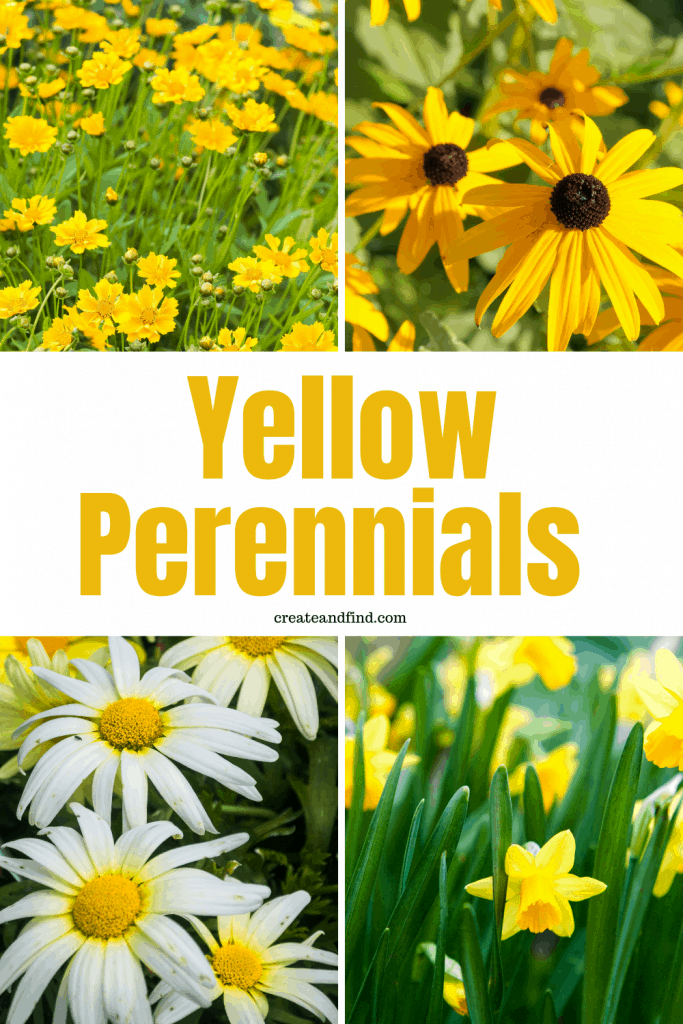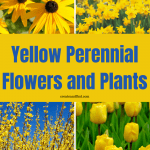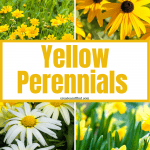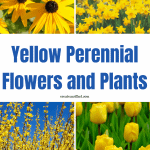Yellow perennial flowers and plants are the perfect cheery additions to your landscaping. Add a few of these to your yard for beautiful color that returns year after year.
There are so many yellow perennial flowers and plants to choose from when planning your flower beds and other landscaping needs. It’s a happy plant color choice that will look like rays of sunshine peeking through. Black-eyed Susans, Daffodils, and Daylilies are just a few of the more popular choices.
What exactly is a perennial flower or plant?
Simply speaking, a perennial is a plant that lives for more than two years. As in, you plant it, and it returns year after year. There are two main classifications of perennial – herbaceous and woody.
Herbaceous perennials die back to the ground each year, the roots survive and you get new plant growth the next year.
Woody perennials include trees and shrubs. The plant does not die each year but may go dormant.
So why do we like perennials?
It’s simple – less work to do each planting season and beauty that returns year after year with minimal effort. Another benefit to planting perennials is you can have plants blooming at all times of the year once you get it all established. Of course, you may still need to prune, trim, or fertilize, but the initial planting is one and done.
Find your Planting Zone by Zip Code here!
Yellow Perennial Flowers and Plants
Black-Eyed Susans
Black-eyed Susans are gorgeous flowers with drooping yellow petals and dark centers. They are otherwise known as Rudbekia and also referred to as coneflowers.
They are fairly easy to grow and don’t require a huge amount of maintenance which makes them a great yellow perennial flower to add to your list!
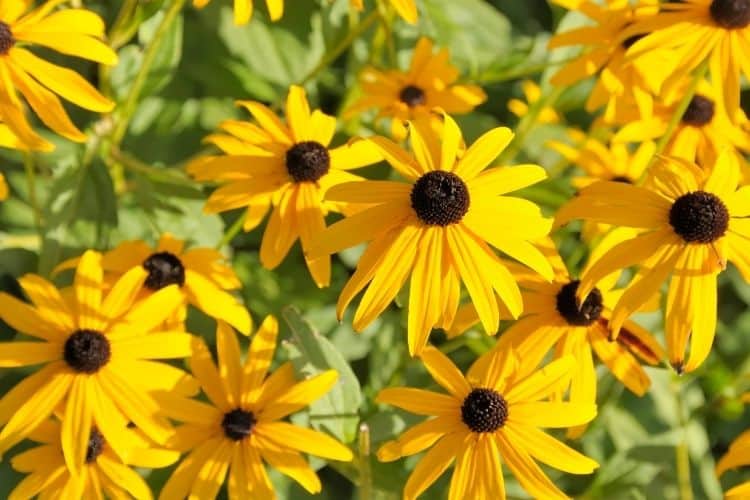
Black-eyed Susan Facts
- Zones 3-9
- Can grow to 18″ to over 6 feet tall depending on variety
- Only certain varieties are perennial flowers so be sure to check before planting
- Prefer full sun
- These do not like soggy soil and when watering, do so at the soil level, not directly on the leaves to prevent disease like powdery mildew
- Pair them with purple coneflowers or purple hearts for a striking contrast in color
Daffodils
We’ve all seen those glorious rows and rows of Daffodils that just look like giant rays of sunshine along the roadside, hillsides, or in flower beds. With their huge numbers of flowers and ease of growing, it’s no wonder these make the list.
Daffodils are plants that are grown from bulbs. So while it takes a bit more preparation and planning initially, you’ll be rewarded with gorgeous yellow perennial flowers year after year.
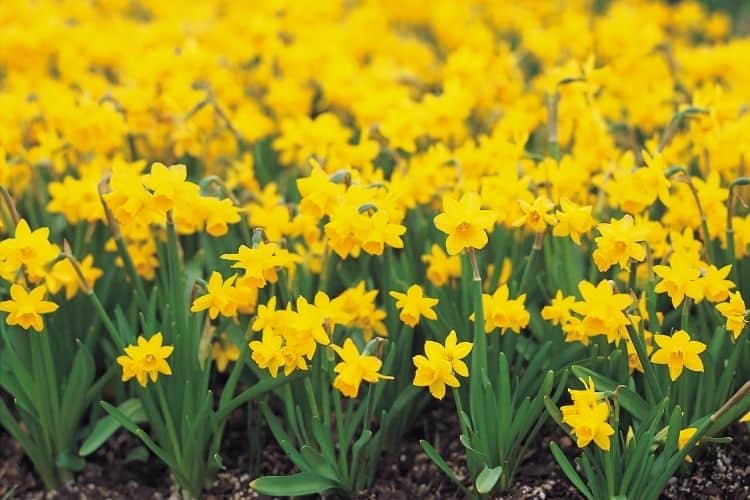
Daffodil Facts
- Zones 3-9
- Prefers full sun and well-drained soil
- Grown from bulbs that are generally planted in the fall at least 2-4 weeks before the ground freezes
- Plant each bulb about 6 inches deep and space them at least 3-6 inches apart
- Cover with mulch and soil
- Blooms will appear in spring in most areas
- Deer Resistant
- Toxic to pets
Daylilies
It’s easy to confuse Daylilies and Daffodils. They look similar in blooms and in foliage. But they’re different and they make excellent planting companions.
Daylilies have a variety of flower colors including yellow, orange, pink, white, and purple. They are easy to grow from the roots.
You will eventually end up with so many in one clump that you can divide them to share or spread throughout your landscaping. Or find a friend that is dividing and score yourself some free plants!
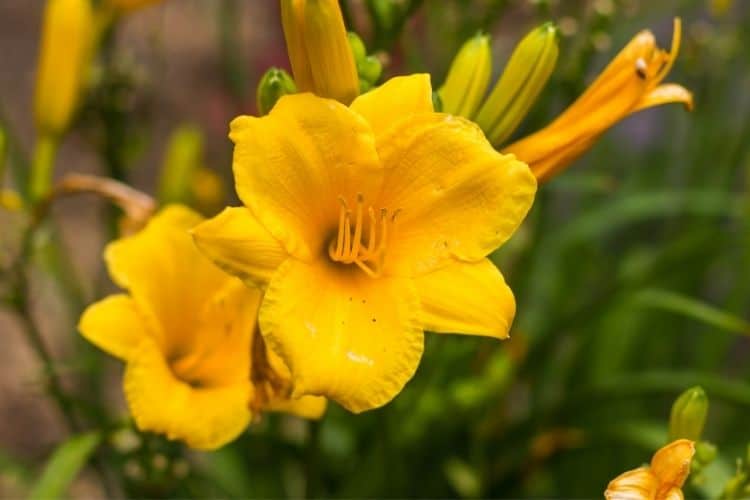
Daylily Facts
- Zones 3-9
- Grown from roots, not bulbs
- Full sun and well-drained soil is the best for these plants
- Divide after 4-5 years for best results
- Very little maintenance required and you’ll find these will survive despite neglect.
- Daylilies can grow 3 feet tall (or taller with some varieties) and 1-3 feet wide so plan accordingly
Shasta Daisy
Shasta Daisies are easy to grow and perfect for beginner gardeners. They are not technically all yellow, but they have a bold yellow center with white petals.
These plants will spread from rhizomes and you can end up with more plants than you planned for.
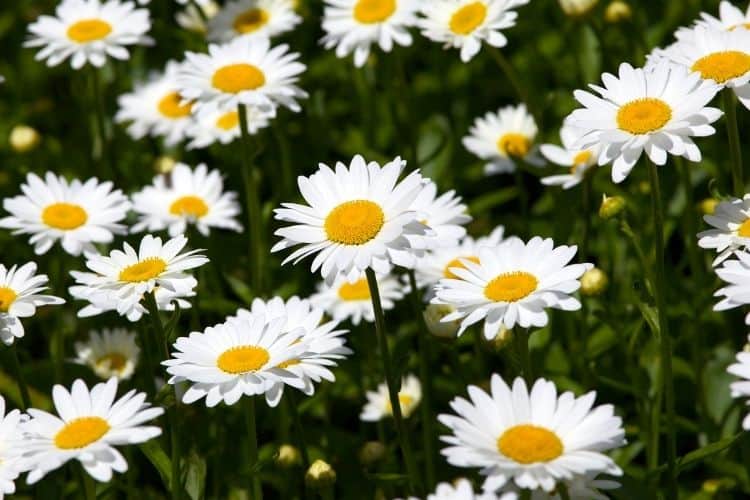
Shasta Daisy Facts
- Zones 4-8
- Prefers full sun but can tolerate light shade
- Grows 2-4 feet wide and high
- Blooms from spring to fall
- Make good cutting flowers
- Can be grown from seed or plants
Coreopsis (Tickseed)
Coreopsis (also known as Tickseed) is a striking flower that grows on long graceful stems with bright green foliage. Some varieties are annuals, so check which one you’re getting.
They grow in mounds and can provide a gorgeous backdrop for lower-lying plants in your garden. Place them behind a row of Vincas or Phlox for a good combination.
If growing from seed, don’t cover the seeds after scattering. They need the sunlight to start sprouting.
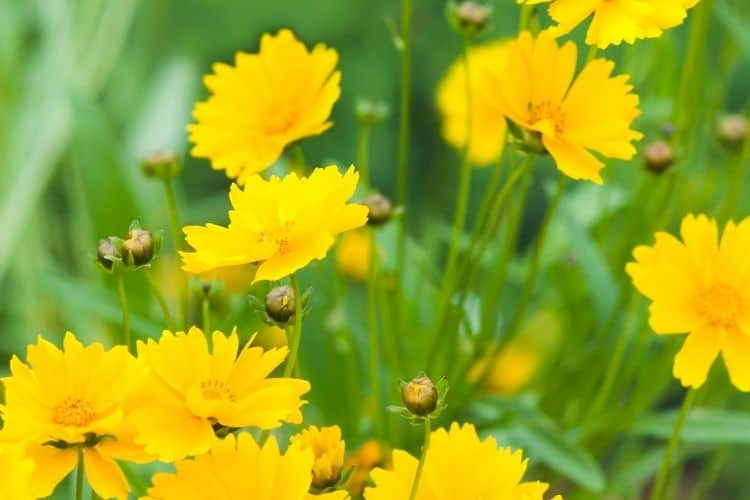
Coreopsis Facts
- Zones 3-10
- Fast-growing
- Prefers full sun
- Grows between 2 and 3 feet tall and wide
- Easy to grow from seed
- Plant in early spring
Hardy Ice Plant (Delosperma)
Hardy Ice Plants are gorgeous groundcover plants that can be grown as a perennial or annual depending on your planting zones.
They are available in a variety of colors including yellow, pink, purple, red, and orange. It’s considered a succulent and requires little maintenance.
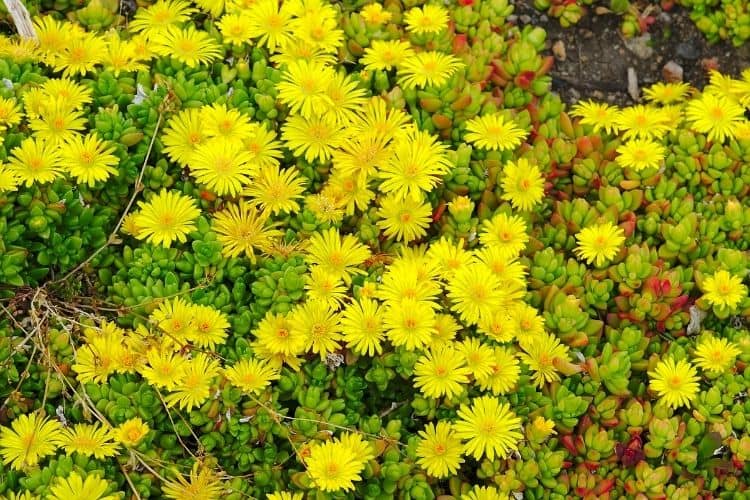
Hardy Ice Plant Facts
- Zones 4-9
- A succulent that prefers full sun, little water needs, and low maintenance
- Give it room to spread as it will grow around 2-3 feet wide, but only about 2 inches tall
- Good for containers, rock gardens, hillsides, and other sunny locations
- Some are evergreen depending on the climate
Forsythia
Forsythia is a deciduous shrub that blooms with vibrant yellow flowers each spring. In my zone (8), the blooming Forsythia signals spring is here and it’s time to get ready preparing the yard with pre-emergent.
These striking leggy blooms are always a welcome sight after a chilly winter and since they are easy to grow, they are a good option for beginner gardeners. After the blooms are finished you will be left with gorgeous green foliage until late fall and winter.
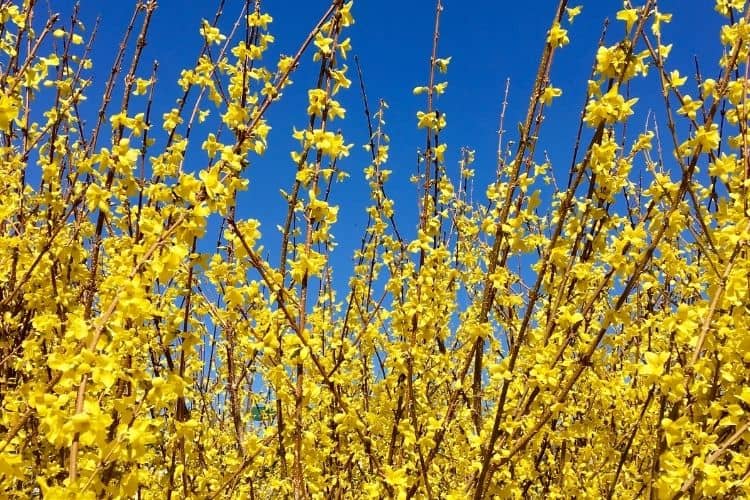
Forsythia Facts
- Zones 4-9
- Deciduous perennial shrub (loses all leaves each winter)
- Fast-growing
- Needs full sun and well-drained soil – these won’t thrive in soggy areas of your yard
- Grows 5-8 feet wide and tall
- Can grow multiple plants from cuttings and can be grown as a hedge
- Can be planted in the fall before the first frost
Tulips
There aren’t many yellow perennial flowers more gorgeous than a tulip. With their cup shaped large blooms and striking green foliage, they are a beautiful addition to any garden.
Tulips are available in nearly every color you can dream of – shades of red, pink, yellow, white, black, purple, and orange to name a few. Blue is just about the only color you can’t get in a tulip.
Whether tulips are perennial or annual can get confusing. The best explanation I found comes from Dutchgrown – you can check it out here.
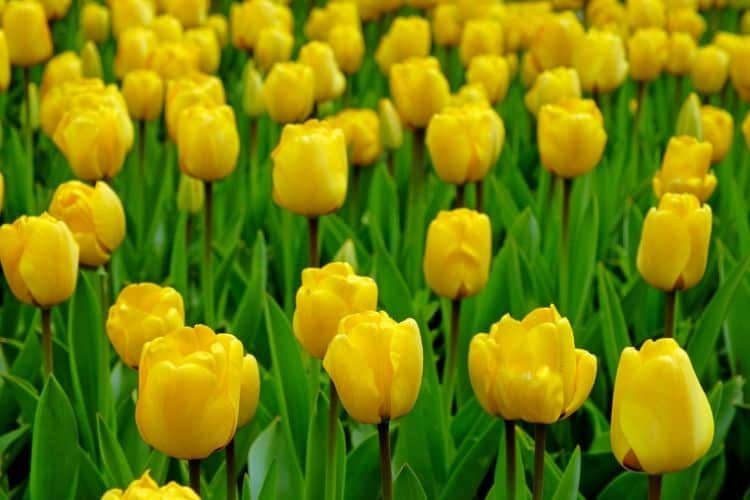
Tulip Facts
- Zones 3-8
- Disease resistant
- Tulips can grow up to 12″ wide and 2 feet tall
- Full sun and well-drained soil are best
- Plant bulbs 3-6 inches apart and plant with tips pointing up
- Bulbs can be stored in a dry place in early summer and replanted in the fall
Inula
Inulas are a beautiful yellow perennial flower with large flowers and spindly looking petals. They make an ideal addition to landscaping because they can tolerate partial shade as well as full sun.
These look like a cross between an Aster and a Sunflower. They can grow up to 7 feet tall so plan these for your wildflower garden or as a backdrop for smaller plants.
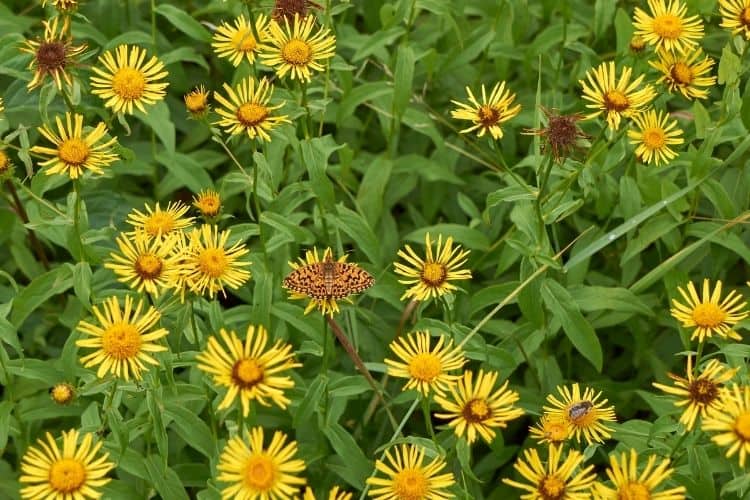
Inula Facts
- Zones 3-9
- Can tolerate full sun or partial shade
- Gets up to 4 feet wide and can grow to 7 feet tall
- Avoid soggy roots for ideal growth and blooms
- Deadhead the flowers after blooming and plants can be cut back to the ground in the fall
Do you have a favorite yellow perennial flower or plant I missed?
If so, I’d love to know – fill me in on your favorites. And check out these ideas for more great perennial flowers you’ll love!
Hopefully, you’ve found a few new ideas from these gorgeous yellow perennial flowers and plants. Happy Planting!
